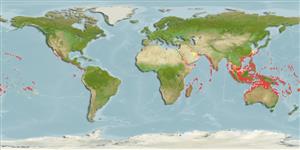Preferred temperature (Ref.
123201): 24.3 - 29, mean 27.8 °C (based on 1320 cells).
Phylogenetic diversity index (Ref.
82804): PD
50 = 0.5000 [Uniqueness, from 0.5 = low to 2.0 = high].
Bayesian length-weight: a=0.03715 (0.01569 - 0.08798), b=2.87 (2.70 - 3.04), in cm total length, based on LWR estimates for this Genus-body shape (Ref.
93245).
Niveau trophique (Ref.
69278): 3.6 ±0.0 se; based on diet studies.
Résilience (Ref.
120179): Milieu, temps minimum de doublement de population : 1,4 à 4,4 années (Preliminary K or Fecundity.).
Fishing Vulnerability (Ref.
59153): Moderate vulnerability (40 of 100).
Nutrients (Ref.
124155): Calcium = 32.9 [13.7, 83.5] mg/100g; Iron = 0.547 [0.284, 1.225] mg/100g; Protein = 18.5 [16.3, 20.6] %; Omega3 = 0.113 [0.058, 0.212] g/100g; Selenium = 41.6 [21.7, 86.4] μg/100g; VitaminA = 42.6 [12.1, 150.8] μg/100g; Zinc = 0.875 [0.594, 1.307] mg/100g (wet weight);
